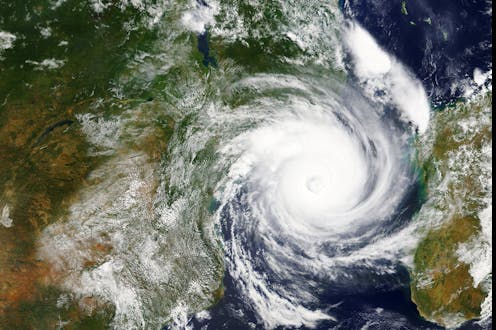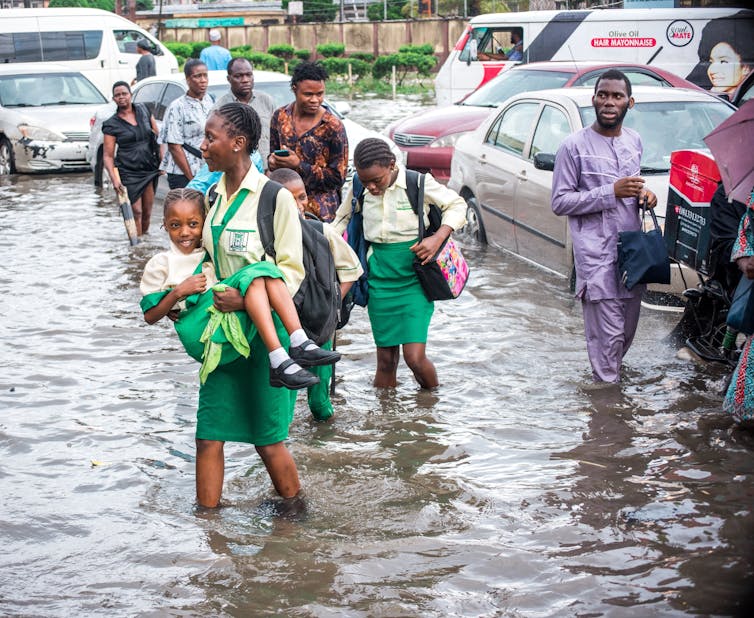
Disasters related to the weather or climate are becoming more common. Since 1970, there has been a five-fold increase in the number of weather-related disasters, causing economic damages that have surged a staggering 70 times over the same period.
This worrying trend is expected to worsen as climate change causes floods, droughts and heatwaves to become more intense, frequent and longer-lasting.
Some places feel the effects of extreme weather more than others. In fact, the damages and deaths caused by extreme weather events are much greater in Africa than in most other parts of the world. Only south Asia experiences more, owing in part to dense populations in countries prone to flooding, such as Bangladesh.
In March 2019, Cyclone Idai hit south-eastern Africa with winds of up to 120 mph. This disaster resulted in more than 1,500 deaths, 2,000 injuries. It affected millions across Madagascar, Malawai, Mozambique and Zimbabwe.
By contrast, Hurricane Ida swept across the eastern United States in August 2021. Despite being only slightly more intense, it resulted in the deaths of fewer than 100 Americans.
So, why was there such a big difference in the loss of life between two similarly strong disasters? Part of the answer lies in the varying levels of readiness and ability to respond.
Preparing for climate disasters
Effective preparation for, and response to, extreme weather and climate events relies on something called a “hydromet system”. The system has multiple layers, consisting of different services that provide weather monitoring, forecasting and early warnings. Each layer cannot function without the previous one.
Wealthier countries take hydromet systems for granted. But many of the necessary layers are absent, outdated or not functioning properly across Africa – leaving African populations vulnerable to extreme weather.
A clear example of this discrepancy is in weather monitoring. Europe and the US have 636 weather radar stations (which are used to track precipitation and estimate its type) for a population of 1.1 billion and a combined land area of 20 million sq kilometres.
Africa, on the other hand, has only 37 radar stations for a population of 1.2 billion and a land area of 30 million sq kilometres. And more than half of these stations do not provide sufficiently precise data for reliable weather forecasting.

African populations bore the brunt of Cyclone Idai because they were caught by surprise. In comparison, residents of the US were instructed to evacuate before Hurricane Ida even made landfall.
It’s only recently that substantial steps have been taken to address this gap. In 2022, the UN and World Meteorological Organization (WMO) together pledged US$3.1 billion (£2.4 billion) to invest in hydromet systems across 30 countries, 13 of which are in Africa.
Although promising, this is insufficient. Since the mid-1990s, the US alone has installed more than 100 modernised next-generation weather radar stations at the same cost as the UN and WMO’s entire pledge.
The pledge also lacks emphasis on maintaining Africa’s weather monitoring systems. The continent deserves a more comprehensive plan. We teamed up with researchers from Kenya and Senegal to develop a roadmap aimed at rectifying the deficiency in weather warning across Africa.
Better weather monitoring
Different countries and communities face different climate risks. East African countries are projected to face warmer temperatures, more evaporation and prolonged droughts in the future. On the other hand, west Africa will experience heavier seasonal rains and widespread flooding.
Once we work out what sort of attention various regions need, Africa’s ability to monitor the weather must be improved.
One way is by investing in more weather radar stations. But these can be very expensive – a single state-of-the-art weather radar station can cost more than US$1 million. And in some places, particularly mountainous regions, radars also leave gaps in their coverage.
Another way is to make better use of satellites to help monitor and predict the weather. Most weather services and meteorological departments in Africa already have access to satellite imagery. But more climatologists and meteorologists need be trained to analyse the satellite data that are currently available.

Clearer early warnings
Better monitoring and forecasting alone will not be enough. The case of Cyclone Idai clearly demonstrates that insufficient warnings of extreme weather events can worsen the impact of climate disasters. Yet these warnings are not consistently and inclusively issued across Africa.
In order to save lives, warning messages must go beyond simply acknowledging a particular hazard. Instead, they should explain the potential consequences of the hazard to local people and provide clear guidance on the necessary steps to reduce the risk. This involves vulnerable groups knowing where to evacuate and what type of equipment they should carry to ensure they remain safe.
A key part of this is using local and understandable dialects to communicate instructions, and transmitting warnings through multiple channels – such as radio, text and social media – when a disaster transpires to ensure maximum reach.
This is not just an existential imperative, but a financial one too. Research by the World Bank estimates that improved hydromet systems could save African countries US$13 billion in asset and infrastructure losses and US$22 billion in livelihood losses per year.
But so far, investing in hydromet systems has not been a priority. When it is discussed, it has been grossly understated and underfunded. This must change.
The authors do not work for, consult, own shares in or receive funding from any company or organisation that would benefit from this article, and have disclosed no relevant affiliations beyond their academic appointment.
This article was originally published on The Conversation. Read the original article.







